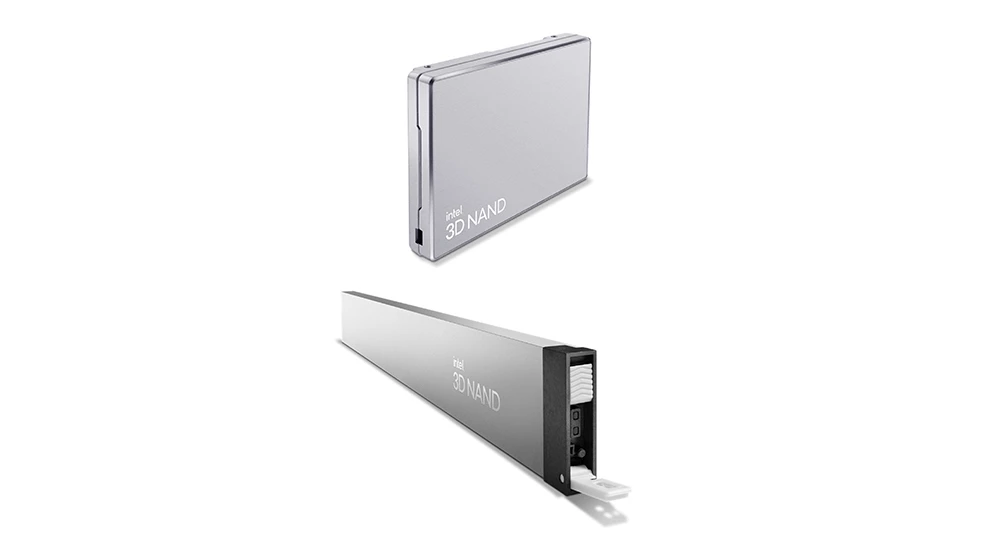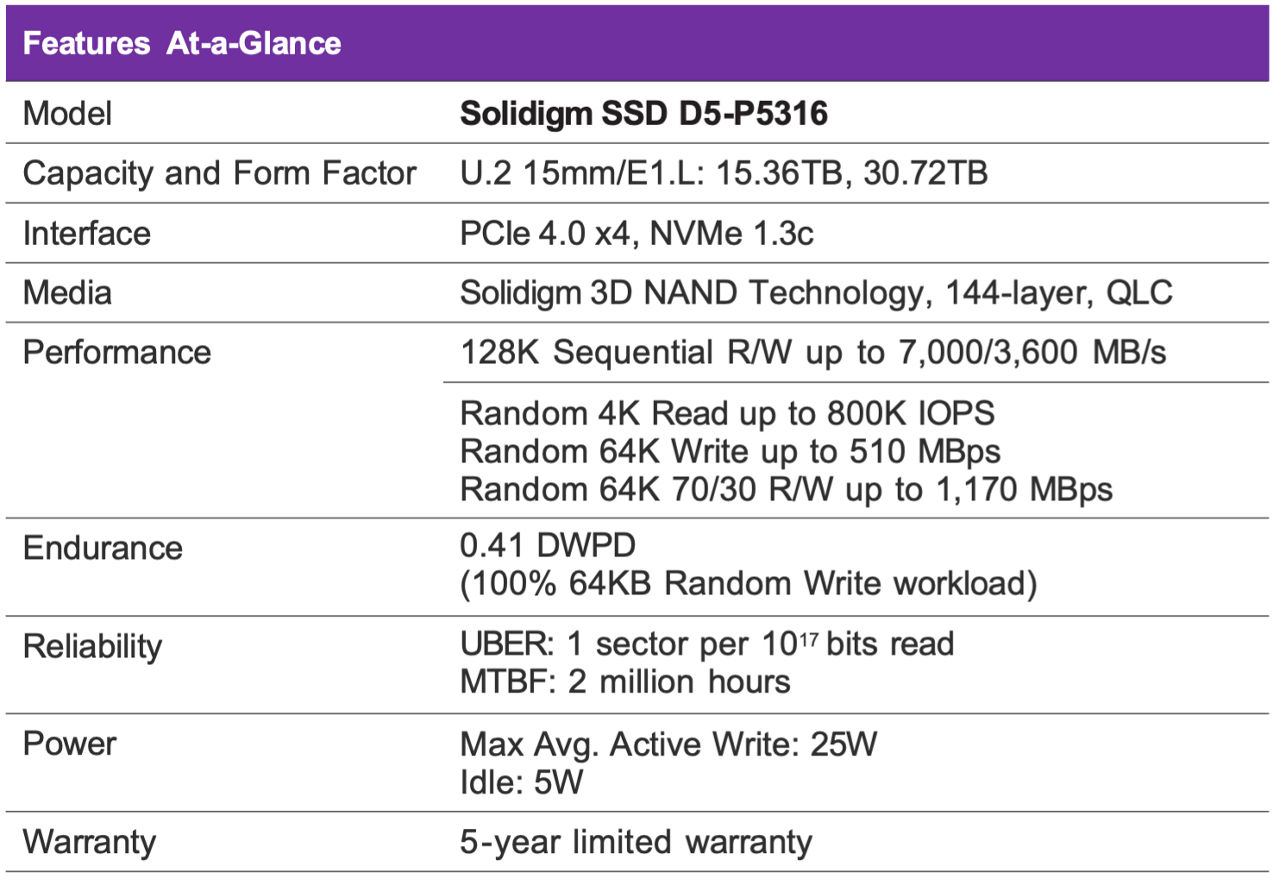Solidigm™ D5-P5316 Product Brief
Formerly Intel® SSD D5-P5316
As data volume increases, storage becomes a growing challenge in terms of cost-effectiveness, physical footprint, and performance. Built with Solidigm’s most advanced Quad-Level Cell NAND, the Solidigm SSD D5-P5316 addresses those challenges by delivering industry-leading SSD storage density with the high bandwidth performance of a PCIe 4.0 interface.
The Solidigm D5-P5316 SSD includes up to 30.72TB of capacity, and as an E1.L, provides up to 1 petabyte of storage in just 1U of rack space. The result is massive storage consolidation for lower TCO.

Built on industry’s first 144-layer QLC
- Consolidate and accelerate warm storage
- Enables up to 1PB of storage in just 1U
- Same quality and reliability as TLC
- Available in U.2 & E1.L form factor
Unlock the value of stored data
Based on PCIe 4.0, the D5-P5316 SSD not only accelerates legacy HDD-based systems but also prior generation Solidigm SSD-based systems. Compared to HDDs, Solidigm’s newest SSD can accelerate access to stored data by up to 25x [1] while performance optimizations bring up to 2x higher sequential read performance, [2] up to 38% higher random read performance, [3] up to 48% better latency, [4] and up to 5x higher endurance versus the previous generation Solidigm SSD family. [5]
In addition to increased performance, the Solidigm D5-P5316 SSD offers storage footprint consolidation with up to 20x reduction of warm storage footprint. [6] Storage consolidation enables further operational savings, including power consumption, cooling costs, drive replacement, and technician support.
Firmware enhancements for drive performance, IT efficiency, data security, and manageability
The Solidigm D5-P5316 SSD includes numerous firmware enhancements specifically optimized for both enterprise and cloud workloads to deliver better latency, [4] expanded management capabilities, and critical new NVMe features.
- NVMe 1.3c and NVMe-MI1.0a-compliant
- Scatter Gather List (SGL) removes the need to double-buffer host data
- Persistent Event Log exposes deeper drive history for debugging at scale
- Designed to enhance security with AES-256 Hardware Encryption, NVMe Sanitize, Firmware Measurement
- Telemetry makes a wide range of stored data accessible and includes intelligent error tracking and logging. This increases the reliability of finding and mitigating issues and supports accelerated qualification cycles—all of which result in increased IT efficiency
Accelerate a range of data center workloads
The D5-P5316 SSD is designed from the ground up to optimize and accelerate storage in a range of Data Center workloads including but not limited to Content Delivery Network (CDN), Hyper Converged Infrastructure (HCI), Big Data, Artificial intelligence (AI), Cloud Elastic Storage (CES) and, High Performance Computing (HPC). Key architectural improvements accelerate a broad range of read workloads as well as large block sequential/random writes, while maintaining fast response time SLAs. The D5-P5316 can support all write sizes with a Quality of Service improvement scheme that maintains low read latency under write pressure.
NAND technology industry leader
Solidigm’s 144-layer 3D NAND technology delivers industry-leading areal density [7] and data retention, [8] enabling enterprise customers to confidently scale storage arrays to meet their growing needs. The swift adoption of software-defined and hyperconverged infrastructures increases the requirement to maximize efficiency, revitalize existing hardware, and increase server agility—all while maintaining operational reliability.

Notes
Test and System Configuration for footnotes 1-6: Testing by Solidigm. Mainboard: Solidigm Server Board S2600WFT, Version: R2208WFTZS, BIOS: SE5C620.86B.00.01.0014.070920180847, Platform architecture: x86_64, CPU: Intel Xeon® Gold 6140 CPU @ 2.30GHz, CPU Sockets: 2, RAM Capacity: 32G, RAM Model: DDR4, OS version: centos-release-7-5, Build id: 1804, kernel: 4.14.74, NVMe Driver: Inbox, Fio version: 3.5, G4SAC PCIe Gen4 switch PCIe card (Microsemi). Solidigm SSD D5-P5316 was tested on ACV10100 firmware. Testing as of March 2021.
[1] Sequential read performance based on Solidigm SSD D5-P5316 compared to Seagate Exos X18 (www.seagate.com/files/www-content/datasheets/pdfs/exos-x18-channel-DS2045-1-2007GB-en_SG.pdf).
[2] Up to 2x higher sequential read - Comparing 128K sequential read bandwidth between Solidigm SSD D5-P5316 15.36TB (7.0 GB/s) and Solidigm SSD D5-P4326 15.36TB (3.2 GB/s).
[3] Up to 38% higher random read - Comparing 4K random read between Solidigm SSD D5-P5316 15.36TB (800K IOPS) and Solidigm SSD D5-P4326 15.36TB (580K IOPS)
[4] Up to 48% better latency performance at 99.999%: Source-Solidigm product specification. Comparing measured performance for 4KB Random Read, QD1 latency performance at 99.999% between Solidigm SSD D5-P5316 15.36TB with Solidigm SSD D5-P4326 15.36TB. Measured performance are 600us and 1150 us for Solidigm SSD D5-P5316 and Solidigm SSD D5-P4326 respectively. Percentage change is 48%.
[5] Up to 5x higher endurance gen over gen - Comparing endurance (64K random write) between Solidigm SSD D5-P5316 30.72TB (22,930 TBW) and Solidigm SSD D5-P4326 15.36TB (4,400 TBW).
[6] Up to 20x Reduction of Warm Storage Footprint. With 4TB HDD drive, it takes 10 (2U) of rack space to fill up 1PB or storage. With Solidigm SSD D5-P5316 30.72TB E1.L or U.2, it takes 1U of rackspace to fill up 1PB of storage. That’s up to 20x greater rack consolidation.
[7] Source: ISSCC 2015, J. Im; ISSCC 2017 R Yamashita; ISSCC 2017 C Kim; ISSCC 2018; H. Maejima; ISSCC 2019 C. Siau.
[8] Measurements were performed on components from SSDs using floating gate and charge trap flash technology. Measurement platform used was Teradyne Magnum 2 Memory test systems, and programming using random patterns and margins were quantified using customer commands. Data measured in 08/2019.
Performance varies by use, configuration and other factors. Learn more at www.Solidigm.com/PerformanceIndex.
Performance results are based on testing as of dates shown in configurations and may not reflect all publicly available updates. See backup for configuration details. No product or component can be absolutely secure.
Your costs and results may vary.
Solidigm does not control or audit third-party data. You should consult other sources to evaluate accuracy. Solidigm technologies may require enabled hardware, software, or service activation.
© Solidigm. Solidigm and the Solidigm logo are trademarks of Solidigm Technology in the U.S. and/or other countries. Other names and brands may be claimed as the property of others.